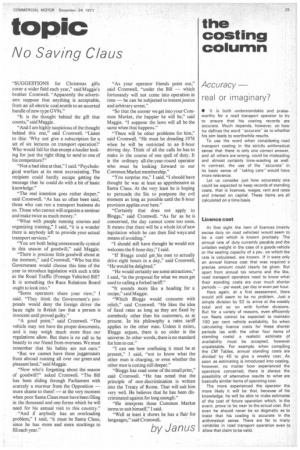the costing column
Page 27

If you've noticed an error in this article please click here to report it so we can fix it.
Accuracy —
real or imaginary?
• It is both understandable and praiseworthy for a road transport operator to try to ensure that his costing records are accurate. Much depends, however, on how he defines the word "accurate" as to whether his aim leads to worthwhile results.
To use the word when considewing road transport costing in the strictly arithmetical sense that there is only one correct answer, and all others are wrong, could be misleading and almost certainly time-wasting as well In contrast, the use of the "accurate" in its basic sense of "taking care" would have more relevance.
Let us consider lust how accurately one could be expected to keep records of standing costs, that is licences, wages, rent and rates and interest on capital. These items are all calculated on a time basis.
Licence cost
At first sight the item of licences (mainly excise duty on road vehicles) would seem to be a cost which is known precisely. The annual rate of duty currently payable and the unladen weight in the case of a goods vehicle or the seating capacity of a psv. on which the rate is calculated, are known. If it were only an annual licence cost that was required a precise amount could clearly be given. But apart from annual tax returns and the like, road transport operators need to know what their standing costs are over much shorter periods — per week, per day or even per hour.
Here again, at a first assessment, there would still seem to be no problem. Just a simple division by 52 to arrive at the weekly total and so on with further divisions. But for a variety of reasons, even efficiently run fleets cannot be expected to maintain 100 per cent vehicle availability. So when calculating licence costs for these shorter periods (as with the other four items of standing costs) a realistic estimate of availability must be accepted, however unpalatable. For example, when compiling the CM Tables, annual standing costs are divided • by 45 to give a weekly cost. As soon as estimating is introduced into costing, however, no matter how experienced the operators concerned, there is always the possibility of alternative results to what are basically similar items of operating cost.
The more experienced the operator the more likely it will be that, because of his knowledge, he will be able to make estimates of the cost of future operation which, in the event, prove to be near to the actual cost. But even he should never be so dogmatic as to insist that his costing is accurate in the arithmetical sense. There are far to many variables in road transport operation even to allow that claim to be valid.




































































